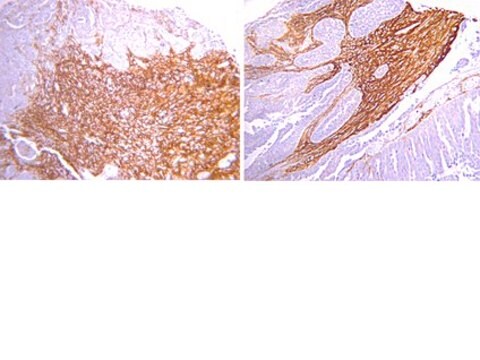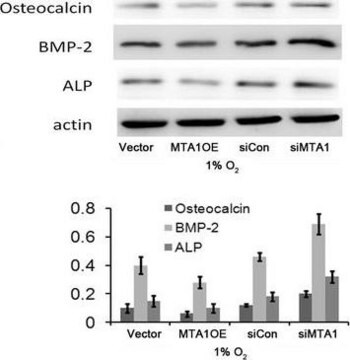AB1870
Anti-Osteopontin Antibody
serum, Chemicon®
Synonim(y):
Uropontin, Bone sialoprotein 1, SPP1/CALPHA1 fusion, Urinary stone protein, bone sialoprotein I, osteopontin/immunoglobulin alpha 1 heavy chain constant region fusion protein, secreted phosphoprotein 1, secreted phosphoprotein 1 (osteopontin, bone sialop
Wybierz wielkość
2910,00 zł
Przewidywany termin wysyłki22 kwietnia 2025Szczegóły
Wybierz wielkość
About This Item
2910,00 zł
Przewidywany termin wysyłki22 kwietnia 2025Szczegóły
Polecane produkty
pochodzenie biologiczne
rabbit
Poziom jakości
forma przeciwciała
serum
rodzaj przeciwciała
primary antibodies
klon
polyclonal
reaktywność gatunkowa
mouse, rat, human
producent / nazwa handlowa
Chemicon®
metody
ELISA: suitable
immunohistochemistry (formalin-fixed, paraffin-embedded sections): suitable
western blot: suitable
numer dostępu NCBI
numer dostępu UniProt
Warunki transportu
dry ice
docelowa modyfikacja potranslacyjna
unmodified
informacje o genach
human ... SPP1(6696)
Opis ogólny
Specyficzność
Immunogen
Zastosowanie
A previous lot of this antibodu was used at a 1:1500 dilution on paraffin-embedded tissue sections.
ELISA:
A previous lot of this antibody was used at a 1:1000 dilution.
Optimal working dilutions must be determined by end user.
Cell Structure
Osteobiology
Jakość
Western Blot Analysis: 1:500 dilution of this lot detected osteopontin on 10 μg of RAW 264.7 lysates.
Opis wartości docelowych
Postać fizyczna
Przechowywanie i stabilność
Handling Recommendations:
Upon first thaw, and prior to removing the cap, centrifuge the vial and gently mix the solution. Aliquot into microcentrifuge tubes and store at -20°C. Avoid repeated freeze/thaw cycles, which may damage IgG and affect product performance.
Komentarz do analizy
POSITIVE CONTROL: Human urine (2-5 µg/mL normal concentration).
Inne uwagi
Informacje prawne
Oświadczenie o zrzeczeniu się odpowiedzialności
Nie możesz znaleźć właściwego produktu?
Wypróbuj nasz Narzędzie selektora produktów.
Kod klasy składowania
10 - Combustible liquids
Klasa zagrożenia wodnego (WGK)
WGK 1
Temperatura zapłonu (°F)
Not applicable
Temperatura zapłonu (°C)
Not applicable
Certyfikaty analizy (CoA)
Poszukaj Certyfikaty analizy (CoA), wpisując numer partii/serii produktów. Numery serii i partii można znaleźć na etykiecie produktu po słowach „seria” lub „partia”.
Masz już ten produkt?
Dokumenty związane z niedawno zakupionymi produktami zostały zamieszczone w Bibliotece dokumentów.
Active Filters
Nasz zespół naukowców ma doświadczenie we wszystkich obszarach badań, w tym w naukach przyrodniczych, materiałoznawstwie, syntezie chemicznej, chromatografii, analityce i wielu innych dziedzinach.
Skontaktuj się z zespołem ds. pomocy technicznej







